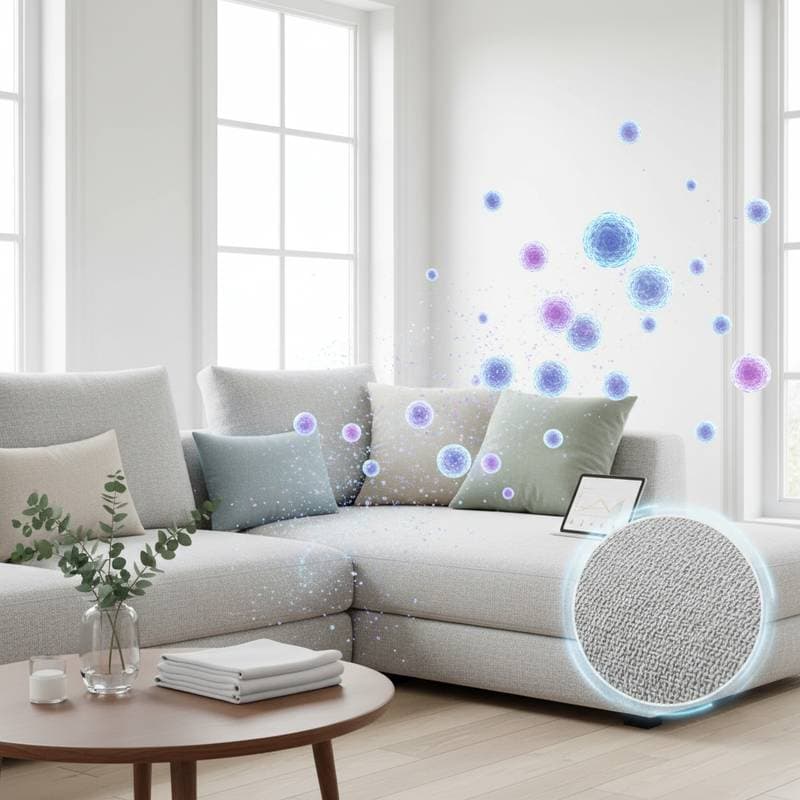Antimicrobial Fabrics Revolutionize Home Health Trends
A cleaner, safer home begins with the surfaces that receive daily contact. Antimicrobial fabrics reduce germs, odors, and allergens in everyday textiles such as upholstery and bedding. These materials maintain freshness longer between cleanings, which simplifies household maintenance.
Soft furnishings like sofas, curtains, and pillows often trap bacteria and moisture, leading to odors and allergens. Antimicrobial fabrics address this issue by inhibiting microbial growth. Readers gain insights into their mechanisms, ideal applications, and maintenance practices.
These fabrics inhibit growth rather than eliminate microbes entirely. Regular cleaning remains necessary to remove dirt and debris.
Tools and Materials
- Mild detergent or fabric-safe cleanser
- Spray bottle for spot cleaning
- Soft cloths or microfiber towels
- Vacuum with upholstery attachment
- Warm water
- Optional: Fabric protector approved for antimicrobial textiles
Dos and Don’ts
Dos:
- Vacuum and air out antimicrobial fabrics on a regular schedule.
- Consult care tags for washing restrictions or temperature recommendations.
- Select gentle cleaners that preserve the protective coating.
- Choose fabrics matched to the traffic level in specific rooms.
- Ensure fabrics dry completely after cleaning to sustain resistance.
Don’ts:
- Assume antimicrobial properties eliminate the need for cleaning.
- Apply bleach or vinegar to treated surfaces without manufacturer approval.
- Combine cleaning products, as this may degrade protective coatings.
- Cover fabrics with impermeable materials like plastic, which can trap moisture.
- Neglect standard hygiene routines, such as laundering pillow covers or vacuuming upholstery.
Cost and Time Snapshot
- Cost range: Antimicrobial upholstery fabrics cost $15 to $50 per yard. Pretreated home textiles, such as bedding or curtains, range from $30 to $200.
- Cleaning costs: Supplies for do-it-yourself cleaning total $5 to $20. Professional upholstery cleaning charges $80 to $200 per item.
- Time: Routine maintenance requires 15 to 30 minutes weekly. Deep cleaning or airing out larger pieces demands a few hours, including drying.
Primary cost factors include fabric composition, item dimensions, and decisions about professional services or eventual replacement.
How Antimicrobial Fabrics Work
Antimicrobial fabrics incorporate physical or chemical barriers to hinder microbial proliferation. Silver ions serve as a frequent additive, disrupting bacterial cell walls and preventing reproduction. Copper-infused threads provide similar benefits while combating odors. Emerging options employ plant-derived agents, such as chitosan from shellfish, for natural antimicrobial effects.
Dr. Helen Rivera, a textile scientist at CleanFiber Labs, explained, "The key is stable integration. When antimicrobial agents bond to the fiber rather than sit on the surface, they last longer through washing and wear."
Manufacturers apply treatments differently. Coatings form a surface layer, while embedded agents integrate during fiber production. Embedded methods offer greater durability, though both approaches lower microbial presence effectively.
Safety and Sustainability
Antimicrobial fabrics enhance hygiene, yet verification of additive safety proves essential. Silver and copper qualify as safe for household use in most cases, although certain chemical treatments might cause skin reactions. Opt for products certified under established textile safety protocols.
For environmentally conscious choices, seek fabrics with recycled content or biodegradable agents. Plant-based treatments deliver protection without metal content, minimizing ecological impact. These selections balance performance with reduced environmental footprint.
Handle disposal of worn fabrics with care. Avoid burning or composting unless certification confirms compostability. Many textile recycling programs accommodate treated materials appropriately.
Common Myths
Myth 1: Antimicrobial fabrics eliminate the need for cleaning.
These materials slow microbial growth but fail to remove accumulated dirt or oils. Cleaning schedules must continue.
Myth 2: Antimicrobial fabrics feel stiff or unnatural.
Contemporary treatments integrate seamlessly, retaining the original softness and texture.
Myth 3: Antimicrobial fabrics suit only institutional settings like hospitals or gyms.
Residential collections now feature aesthetic designs ideal for living rooms and bedrooms.
Myth 4: Antimicrobial fabrics damage the environment.
Sustainable variants with low leaching potential avoid such issues. Certification ensures eco-friendly options.
Troubleshooting Common Issues
Musty odors persisting after cleaning often indicate trapped moisture in underlying cushions. Remove covers, air them out, and dry thoroughly before reassembly.
Discoloration signals potential damage from aggressive cleaners. Transition to milder solutions and employ light wiping instead of scrubbing.
Skin irritation requires review of the additive composition. Metal ions provoke reactions in some individuals. Substitute with plant-based alternatives for relief.
Pro Tips for Success
- Verify compatibility of cleaning products with the fabric treatment before use.
- Maintain indoor humidity below 60 percent to optimize antimicrobial performance.
- Install washable liners beneath cushions to shield inner foam from spills.
- Store off-season items in breathable cotton storage bags rather than plastic.
- Monitor freshness duration for each fabric to determine timing for re-treatment or replacement.
Integrating Antimicrobial Fabrics into Daily Life
Healthier homes emerge from deliberate material selections and routines. Antimicrobial fabrics curb unseen contaminants and streamline upkeep. They foster confidence in hygiene without demanding excessive effort.
Select appropriate fabrics, adhere to cleaning protocols, and leverage natural ventilation and sunlight. Gradually, living spaces achieve sustained freshness, reduced odors, and enhanced well-being through efficient practices.
